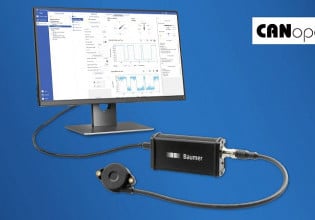AI-enabled Platforms Achieve New Levels of Production Efficiency
Digitalization is steadily gaining importance to help manufacturers meet changes in the process industry, however, modern digital solutions must represent the interaction of both machine parameters and tribal knowledge.
The past several years have brought undeniably rapid changes to the conditions of the process industry from both an operational and a business perspective. While competitive pressure increases, adaptive systems offer an opportunity for more efficient production processes. Digitalization using artificial intelligence (AI) is steadily gaining significant importance to help manufacturers meet these changes. Integrating AI and tribal knowledge into enterprise platforms can provide a powerful assistant in 24/7 operations.

Figure 1. Modern digital solutions must represent the interaction of both machine parameters and tribal knowledge.
AI-enabled Platforms for Evolving Challenges
Companies in the process industry must respond to rapidly changing conditions. Natural gas prices show, for example, the enormous pressure to which the process industry is exposed and, at the same time, how volatile the framework conditions have become. In addition, complexity in production has increased steadily in recent years due to constantly changing market requirements and technological innovations. Competitive pressures present process engineers and operations management decision makers with uncertainties and new challenges.
For production teams, this means that processes must be optimally controlled and malfunctions must be eliminated as quickly as possible. After all, unplanned downtime is very costly. At the same time, every shift team can understand how difficult it can be to make the right decisions or how time-consuming it can be to resolve incidents. In many cases, similar incidents or conditions have occurred in the past. In many cases, corresponding solutions to the problem have even been documented. Having existing knowledge, operational incidents can be avoided or quickly eliminated. But when issues arise in production, employees need more time to sift through written documentation and records.
Naturally, frustration is high when digitally documented solutions are available but cannot be found. More seriously, if the workforce cannot quickly access process-relevant information, the efficiency of the plant declines with every passing minute—and time and revenue are lost as a result. Adaptive systems that learn from past data and provide solutions are in demand.

Figure 2. The future of the process landscape requires humans to remain in control while being supported by machines and AI.
A Focus on Human-centric AI
With the goal of making Plant Process Management (PPM) sustainably more efficient, powerful systems, machines, and AI are becoming increasingly important in production. But the digital transformation in the process industry must center on people. Machines or algorithms cannot react to changes and take responsibility for the safety of processes and plants—only people can do this.
The goal is to create a process landscape in which humans remain in control while being supported in the best possible way by machines, digital communication, and powerful, cognitive assistance systems—in other words, machine-assisted humans. The future of the process industry requires solutions in which machines and AI support employees so that maximum efficiency and safety can be achieved in 24/7 shift operations. AI acts like an assistant on the side of production workers. Ultimately, decisions in production plants are made by humans but can be supported by the knowledge of an AI.
Case in Point
To create a decision-making process that takes a holistic view of process disturbances, a well-thought-out algorithm is needed. It is no longer sufficient to rely on simple "IF-THEN" programming. The amount of data, the flow of information, and the process landscape are too complex for this.
When a piece of equipment fails, it is common for shift teams to perform standard reset and troubleshooting procedures to no avail. When more experienced production staff arrive, their knowledge provides context: "The last time it was freezing outside, the line for the liquid partially froze. This changed the pre-product, which eventually caused the line to stop later." This example illustrates that human language can decisively explain contexts in the operational process.

Figure 3. AI provides workers with well-founded approaches to solutions.
The Value of Smart Searches
There are now enterprise platforms on the market today that integrate the newest AI-supported features to address this challenge precisely. AI capabilities like smart search provide production teams with process-relevant knowledge in a user-friendly format—and as spontaneously as needed. The AI function aims to provide employees with the best possible support in the form of relevant information and suggested solutions from the past.
A major challenge is that two different workers’ descriptions for the chain of events described earlier would look completely different. If we now consider that thousands of entries occur in operational communication, the problem becomes clear. With conventional means, searching for an existing event is like searching for a needle in a haystack. This is exactly where AI algorithms come in to assist in finding solution descriptions. This allows shift personnel to more efficiently and, most importantly, more quickly use historical knowledge to make predictive, informed decisions, thereby avoiding or more quickly resolving disruptions.
In classical programming, the human defines the algorithm and tells it exactly what criteria should be used to perform actions. In contrast, AI can learn these criteria by recognizing patterns in the data. The algorithms can then provide predictions of estimated outcomes with certain probabilities, whereas humans offer the framework for the data search. The algorithm adjusts the search criteria accordingly based on intelligence. From this, correlations in the data can be determined faster than a human can work out that logic. AI provides production teams with desired results and picks up on various details in addition to the problem. In this way, AI enables well-founded approaches to solutions.

Figure 4. Real-time information helps to further increase efficiency and safety in plant operation.
Enhancing Interactive Operational Communication
Data is a fundamental prerequisite of AI. This is important in terms of the quantity and even more so in terms of the data quality. Only when sufficiently good data is available can AI algorithms be meaningfully trained.
Now on the market are enterprise platforms developed specifically for the process industry and that enable a solid database: in addition to plant performance, work orders and incidents are displayed transparently in digital overviews. In this way, interactive operational communication in shift operations is ensured. At the same time, shift logs are recorded in an audit-compliant manner and can be retrieved at any time. The data basis—the documented wealth of experience of the employees—expands with each new entry and can even be used across locations. As a result, the real-time information helps to further increase efficiency and safety in plant operation.
Plant malfunctions often cannot be rectified during the ongoing shift but must be communicated to the following shift team. Here, too, the advantages of the multifunctional enterprise platform are evident. Shift handovers can now be used efficiently without process-relevant knowledge being lost. Smart search capabilities show the production teams which solution approaches are target-oriented for certain malfunctions and which are not.
Delivering AI-enabled Insights
Suggested solutions or recommendations are only part of the potential of Smart Search capabilities. In addition to filtering stored information, a smart search can process communications by cataloging and indexing topics, keywords, phrases, and more. Thus, Smart Search provides insights into the overall picture of the situation and delivers solutions that have already been proven to work in the event of disruptions.
Ultimately, standardized processes and workflows are essential in the process industry; however, different processes, languages, and even communication capabilities create enormous diversity in the process landscape. Where the previous programming can no longer handle information inflows that do not conform to a precise format with prescribed form fields for data entry, new, smarter technologies are taking hold. The overarching goal is to take human-to-human communication and knowledge management to a new level.






